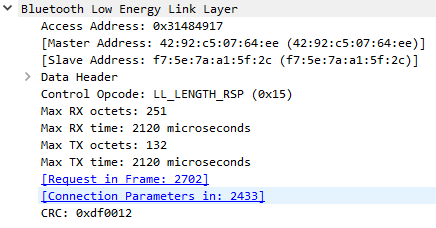During my development, I found NRF5 SDK only supports symmetric RX/TX data length settings.
Here is the on_data_length_update_request_evt in nrf_ble_gatt.c file.
static void on_data_length_update_request_evt(nrf_ble_gatt_t * p_gatt, ble_evt_t const * p_ble_evt)
{
ble_gap_evt_t const * p_gap_evt = &p_ble_evt->evt.gap_evt;
nrf_ble_gatt_link_t * p_link = &p_gatt->links[p_gap_evt->conn_handle];
// The SoftDevice only supports symmetric RX/TX data length settings.
uint8_t const data_length_requested =
p_gap_evt->params.data_length_update_request.peer_params.max_tx_octets;
NRF_LOG_DEBUG("Peer on connection 0x%x requested a data length of %u bytes.",
p_gap_evt->conn_handle, data_length_requested);
uint8_t const data_length_effective = MIN(p_link->data_length_desired, data_length_requested);
(void) data_length_update(p_gap_evt->conn_handle, data_length_effective);
}
It clearly indicates SDK only supports symmetric RX/TX data length settings.
When other Bluetooth devices send LL LENGTH RSQ, NRF will only take a minimum value to reply with the same RX TX.
This is also verified in wireshark.
But, I can still manually set an unsymmetric parameter and reply via sd_ble_gap_data_length_update.
case BLE_GAP_EVT_DATA_LENGTH_UPDATE_REQUEST:
{
ble_gap_data_length_params_t params =
{
.max_rx_octets = 251,
.max_tx_octets = 132,
.max_rx_time_us = 2120,
.max_tx_time_us = 2120,
};
err_code = sd_ble_gap_data_length_update(conn_handle,¶ms,NULL);
APP_ERROR_CHECK(err_code);}
It also can works and verified in wireshark.

So I'm wondering if it's a wrong behavior that I manually reply the unsymmetric parameters?
Does it take effect inside the Bluetooth stack? Does the data transfer really follow this unsymmetric parameter?
Any reply will be appreciated.


